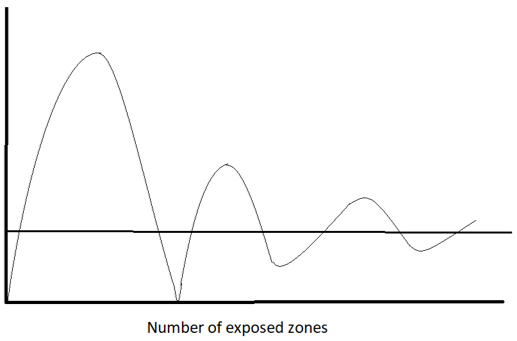This set of Engineering Physics Multiple Choice Questions & Answers (MCQs) focuses on ” Fresnel Diffraction”.
1. How many lenses are used in Fresnel Diffraction?
a) Two Convex lenses
b) Two Concave lenses
c) One Convex lens
d) No lens used
View Answer
Explanation: In Fresnel Diffraction, no lenses are used. The interference takes place between different light waves arriving at a point from the same wavefront. In this case, the phase of all the waves is not the same.
2. Which of the following is called the obliquity factor?
a) cosθ
b) sinθ
c) 1 + cosθ
d) 1 + sinθ
View Answer
Explanation: The effect at a point fie to any particular zone is proportional to 1 + cosθ, called the obliquity factor. Naturally, the effect is maximum whenθ` = 0.677.
3. In Fresnel diffraction, the relative phase difference between the curved wavefront is ____________
a) Constant
b) Zero
c) Linearly increasing
d) Non=constant
View Answer
Explanation: Since the radii of each half period zone are different, the distance traveled by each wavefront is different. Thus, the relative phase difference turns out to be non-constant.
4. What is the variation in the pattern observed for single slit Fresnel diffraction than single slit Fraunhofer Diffraction?
a) The pattern is not hyperbolic
b) The fringes are too thin
c) The region of minimum intensity is not completely dark
d) The fringes are colored
View Answer
Explanation: The diffraction pattern due to the single slit Fresnel Diffraction is similar to single slit Fraunhofer Diffraction, except the regions of minimum intensity are not completely dark. This is so because there is never a complete destructive interference in Fresnel Diffraction.
5. The radius of the half period zone is proportional to ___________
a) The wavelength of light
b) The square root of the frequency of light
c) The square root of the wavelength light
d) The frequency of light
View Answer
Explanation: We know that the formula for the radius of half period zone =\(\sqrt{nb\lambda}\), where n is a natural number. Thus, it is proportional to the square root of wavelength light and inversely proportional to the square root of the frequency of light.
6. Intensity at O due to the entire wavefront is x times that due to the first half period zone. What is x?
a) 4
b) 2
c) 1/2
d) 1/4
View Answer
Explanation: The formula for intensity = \(\frac{m_1^2}{4}\)
The intensity due to the first half period zone = m12
Thus, the intensity at O due to the entire wavefront is 1/4 times that due to the first half period zone.
7. Light of 5000 Å is incident on a circular hole of radius 1 cm. How many half period zones are contained in the circle if the screen is placed at a distance of 1 m?
a) 20
b) 200
c) 2000
d) 20000
View Answer
Explanation: In this case, λ = 5000 Å = 5 X 10-5cm, b = 1m = 100cm
Therefore, Number of half period zones = \(\frac{1}{λ}\)
= 1/5 X 10-5
= 20000.
8. Light of 6000 Å is incident on a circular hole and is received on a screen 50 cm away. What is the radius of the hole, if the intensity of light on the screen is 4 times the intensity without the hole?
a) 0.025 cm
b) 0.047 cm
c) 0.054 cm
d) 0.089 cm
View Answer
Explanation: The intensity will be 4 times than in its absence if the radius of the hole is equal to that of the first half period zone.
Therefore, radius, r = \(\sqrt{b\lambda}\)
Here, b = 50 cm and λ = 6000 Å = 6 X 10-5cm
r = 0.0548 cm.
9. The zone plate behaves like a ____________
a) Concave Lens with multiple foci
b) Convex Lens with multiple foci
c) Convex Lens with single foci
d) Concave Lens with single foci
View Answer
Explanation: In a zone plate, a much brighter image of an object is obtained at the screen, which shows the converging action of a zone plate. Also, it’s equation resembles that of a lens. Thus, the zone plate behaves like a convex lens with multiple foci.
10. The radius of the first zone in a zone plate of focal length 25cm for a light of wavelength 5000 Å is ____
a) 0.01 cm
b) 0.02 cm
c) 0.03 cm
d) 0.04 cm
View Answer
Explanation: Here, f1 = 25cm, λ=5000 Å = 5 X 10-5 cm.
Now using the formula, \(f=\frac{r^2}{nλ}\)
r1 = \(\sqrt{fλ}\)
= 0.03 cm.
11. Which graph is shown in the figure?

a) Amplitude variation with the number of exposed zones
b) Intensity variation with the number of exposed zones
c) Frequency variation with the number of exposed zones
d) Phase variation with the number of exposed zones
View Answer
Explanation: The figure shows the variation of intensity with the number of exposed zones. We know, the resultant intensity at O is \(\frac{m_1^2}{4}\). Only the first half period zone is effective in producing the illumination at O.
12. During a straight-edge diffraction experiment, a light of wavelength 400 nm was used. What would be the position of the first minimum, if the separation between the edge and the source is 10 cm while that between the edge and eyepiece is 2 m?
a) 1.01 cm
b) 2.03 cm
c) 0.57 cm
d) 1.56 cm
View Answer
Explanation: λ = 4000 Å = 4 X 10-5cm, a = 10 cm and b = 200 cm
Location for first maximum, x1 = \(\sqrt{\frac{2b(a+b)\lambda}{a}}\)
= \(\sqrt{0.336}\)cm
= 0.57 cm.
Sanfoundry Global Education & Learning Series – Engineering Physics.
To practice all areas of Engineering Physics, here is complete set of 1000+ Multiple Choice Questions and Answers.
If you find a mistake in question / option / answer, kindly take a screenshot and email to [email protected]
